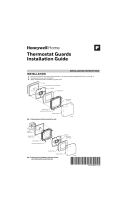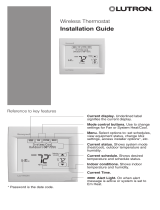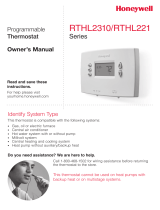Série PRO 1000 / 2000
Configuration par l’installateur
Suivre les étapes ci-dessous pour personnaliser et
configurer le thermostat selon le système de chauffage/
refroidissement.
1 Appuyer simultanément sur et (pendant
trois secondes) jusqu'à ce que l'affichage
ci-contre apparaisse à l'écran.
2 Appuyer sur ou v pour changer d'option.
3 Appuyer sur et pendant une seconde pour
passer à la fonction suivante.
4 Lorsque la dernière fonction est affichée, appuyez
sur >\ et pour enregistrer toutes les
modifications et sortir du menu.
NOTA : S i vo u s n ’a p pu y e z s u r a u cu n b o uto n p e n d a n t 60 s e co n d es lo rsq ue vou s ê te s da n s le
m e n u , le th e rm o s ta t e n re g is tre ra to u te s le s m o d ifica tio n s e t s o rtira d u m e n u a u to m a tiq u e m e nt.
P o u r le s m o dè le s p ro g ra m m a ble s, vou s p o u v e z e n re g is tre r en to u t te m p s le s m o d ifica tio n s et
s o rtir d u m e n u en a p p u y a n t Run.
1
1n
U
Numéro de
la fonction
Numéro
de l’option
Fonction1 Réglage
par défaut Options
1 Format d'affichage de la
température 00 : Fahrenheit
1 : Celsius
2 Format d'affichage de l'heure 0 0 : format 12 heures
1 : format 24 heures
3 Cycles de chauffage/heure 5
2 à 6 cycles par heure
• 2 : 30 min (vapeur, gravité)
• 3 : 20 min (eau chaude, fournaise 90 %+ haute
efficacité)
• 4 : 15 min (gaz ou mazout)
• 5 : 12 min (gaz ou mazout)
• 6 : 10 min (électrique)
4 Cycles de refroidissement/heure 3 2 à 6 cycles par heure
5 Protection du compresseur2 10 : désactivé
1 : activé
6 Adaptive Intelligent Recovery3 10 : Arrêt
1 : Marche
7 Application4 00 : mode Intérieur : 4.5 °C to 32 °C (40 °F to 90 °F)
1 : mode Garage : 1.5 °C to 32 °C (35 °F to 90 °F)
1 Selon le modèle de votre thermostat ou votre système, il se peut que certains fonctions ne soient pas
disponibles ou ne soient pas utilisés.
2 Le compresseur risque d'être endommagé s'il redémarre trop tôt après son arrêt. Cette fonction oblige le
compresseur à attendre 5 minutes avant de redémarrer. Pendant cette attente, la mention Cool On ou Heat
On clignote à l'écran. Une fois la période écoulée, le message cessera de clignoter et le compresseur
démarrera.
3 Adaptive Intelligent Recovery permet au thermostat « d'apprendre » combien de temps il faut au système
de chauffage ou de refroidissement pour atteindre la température programmée. Il suffit de programmer les
heures et les températures désirées dans l'horaire. Le thermostat démarrera le chauffage ou le
refroidissement à l'heure nécessaire pour que la température désirée soit atteinte à l'heure programmée.
4 En mode Intérieur, la consigne minimale est de 5 °C (40 °F) pour la protection contre le gel. En mode
Garage, la consigne minimale est de 1.5 °C (35 °F) pour permettre des économies d'énergie.
5
FRANÇAIS

























